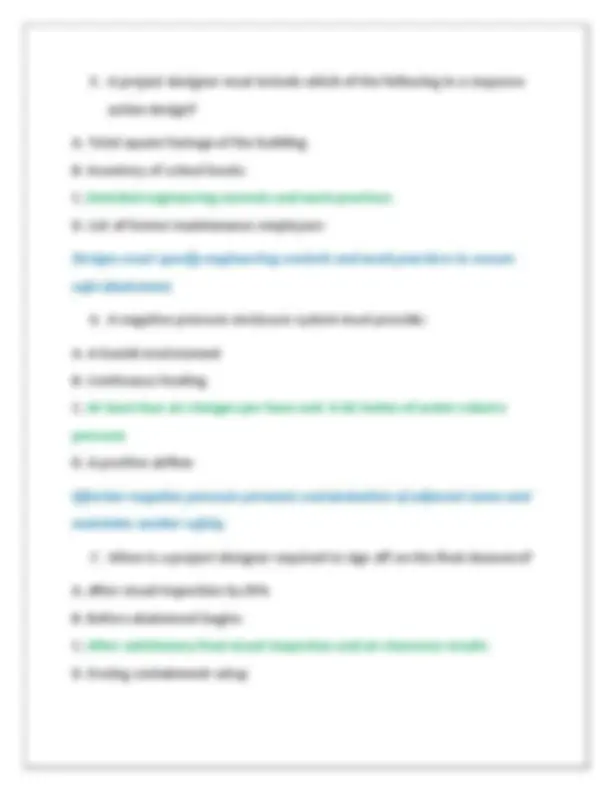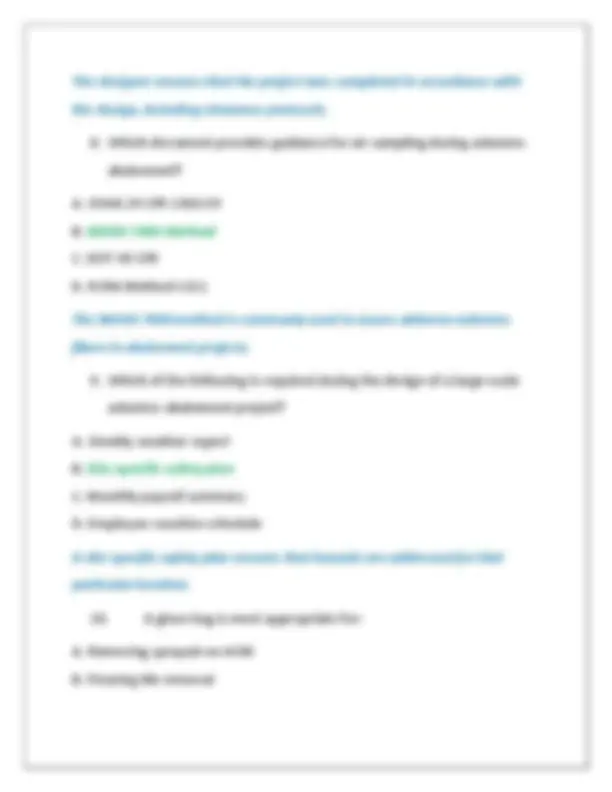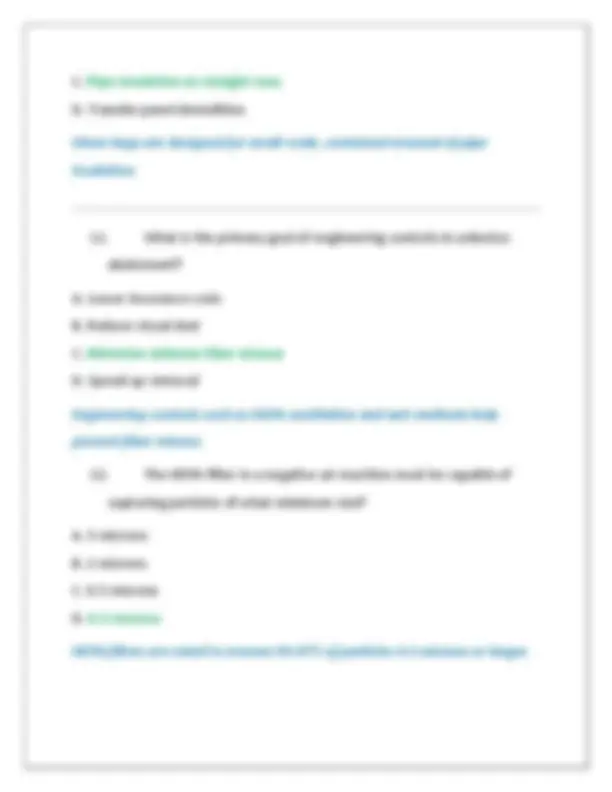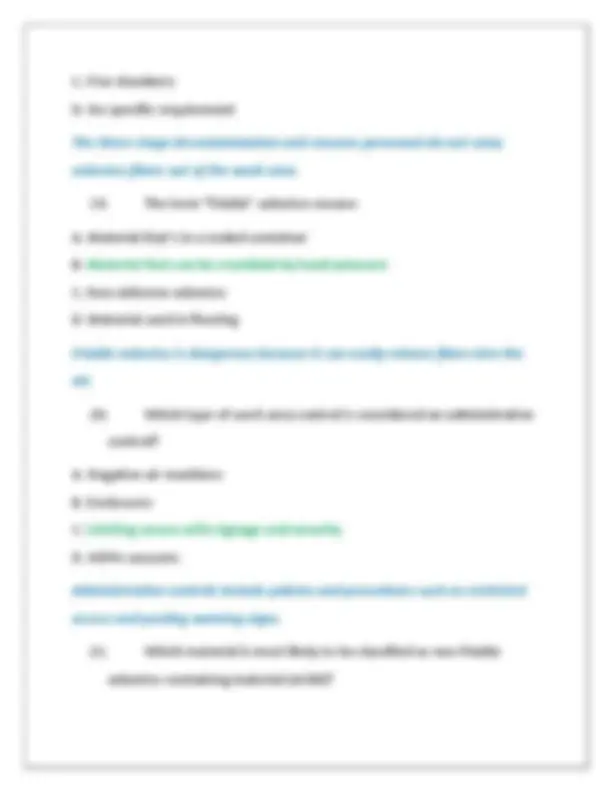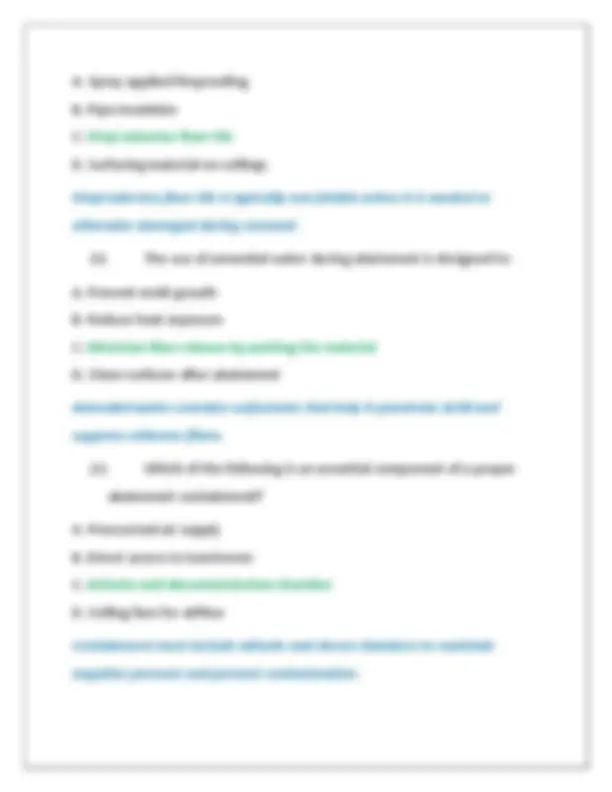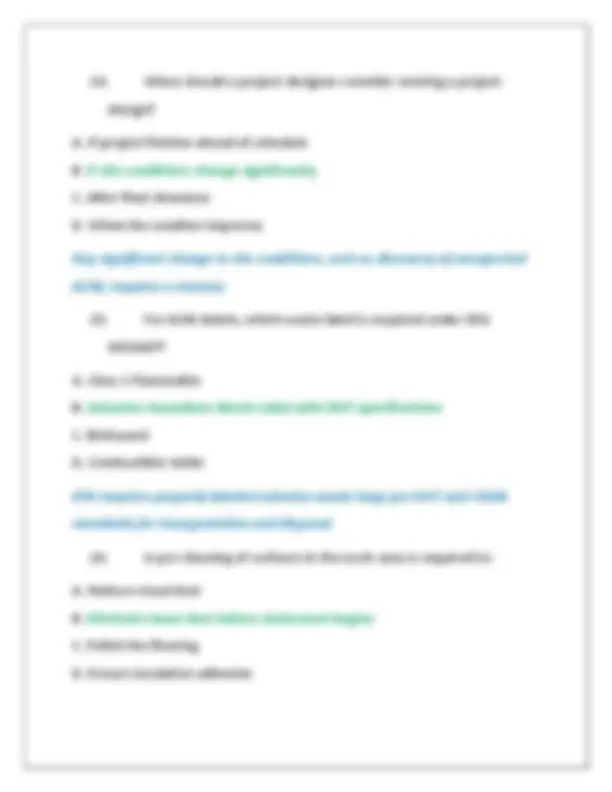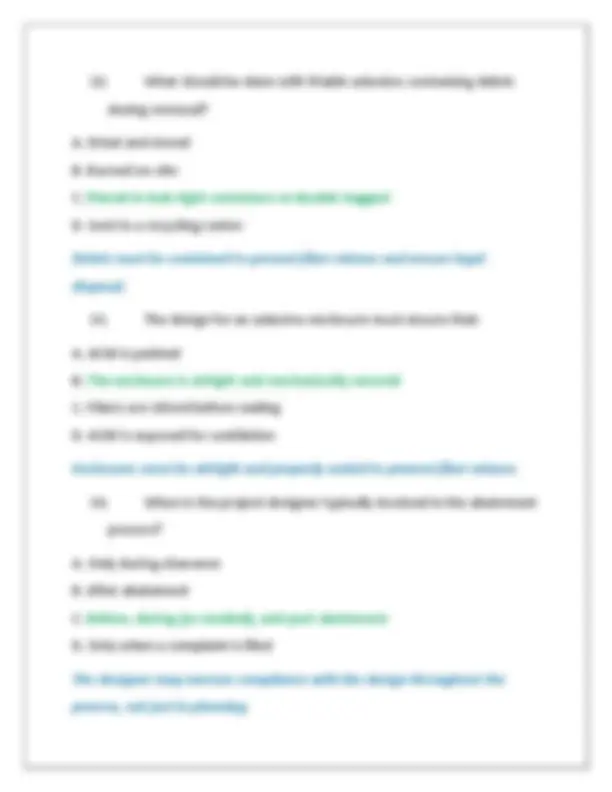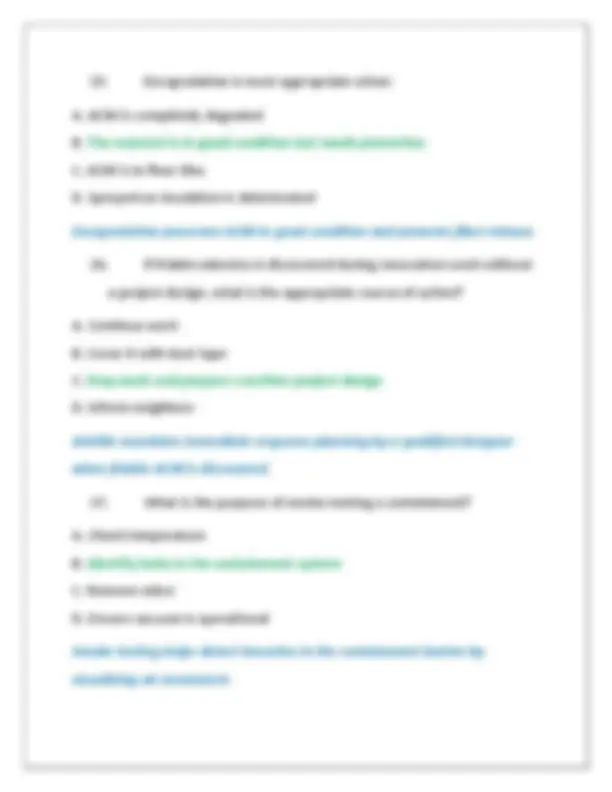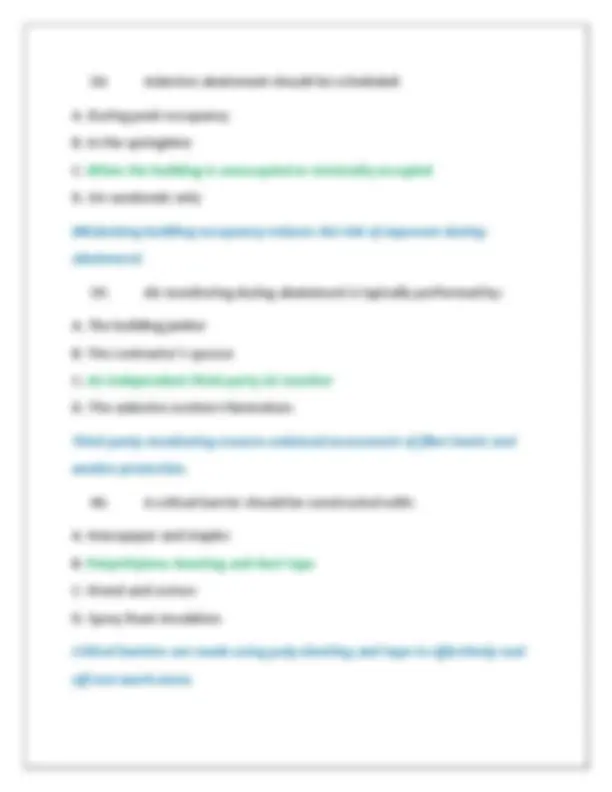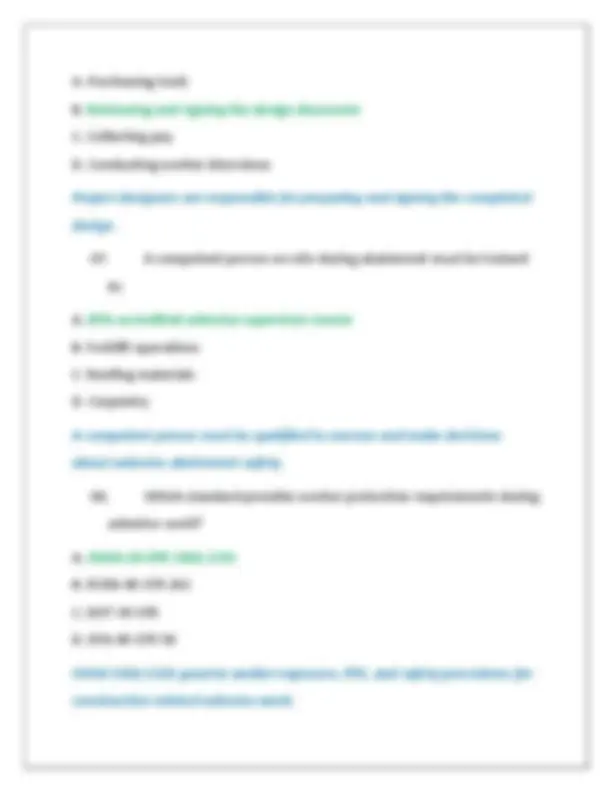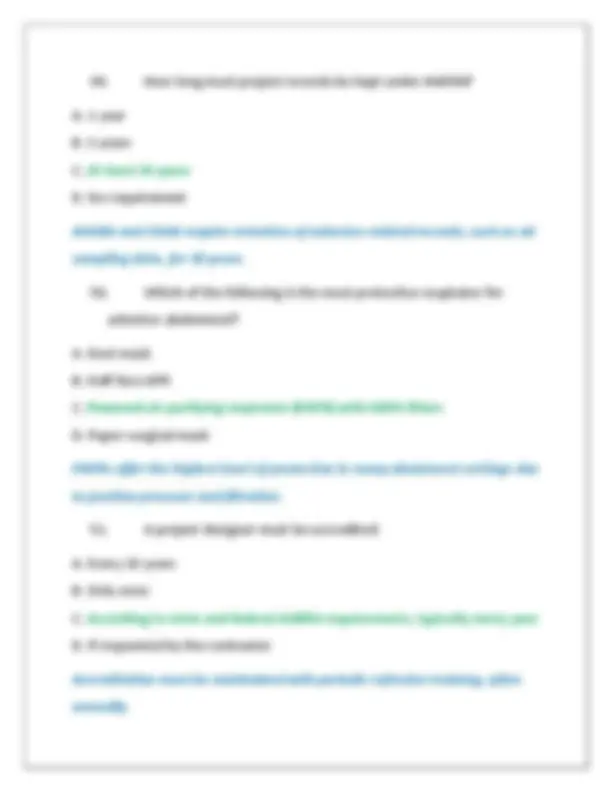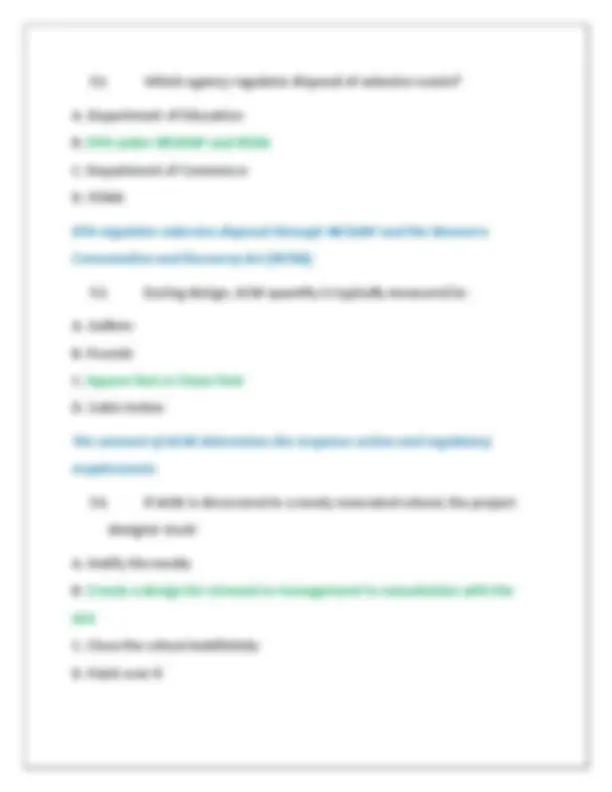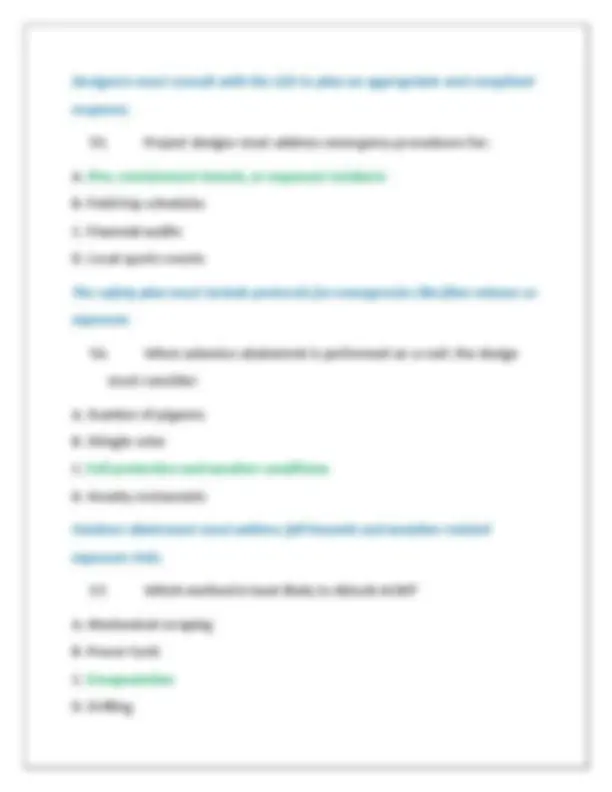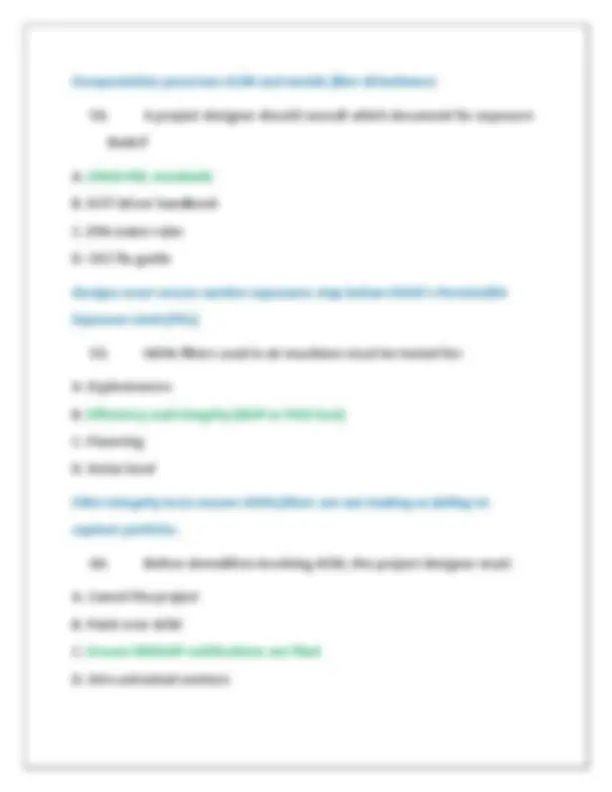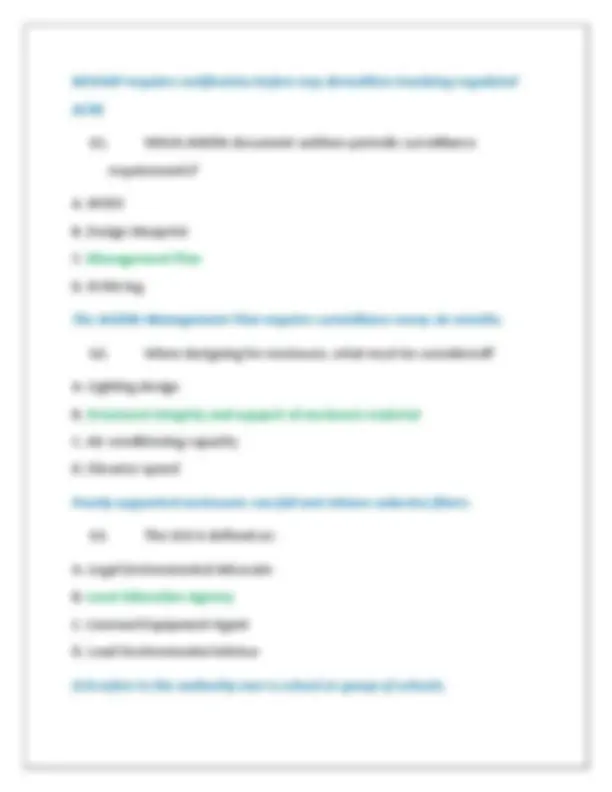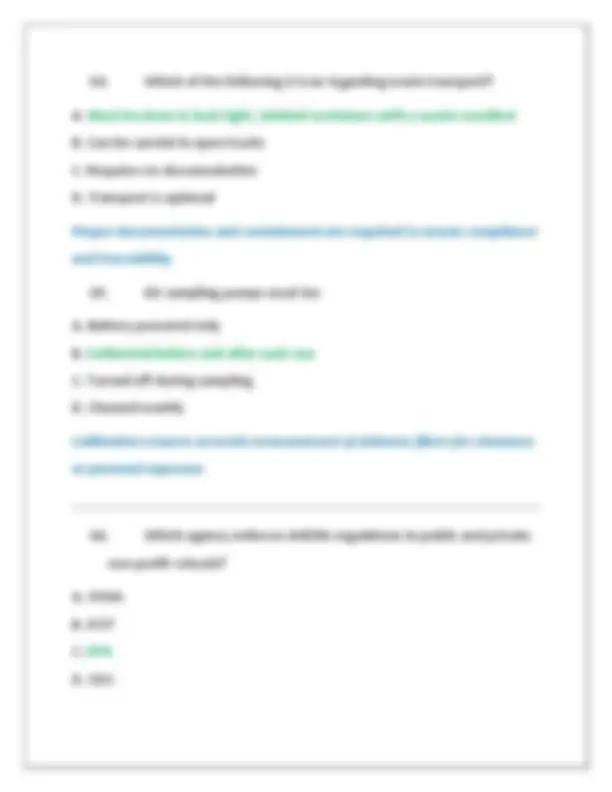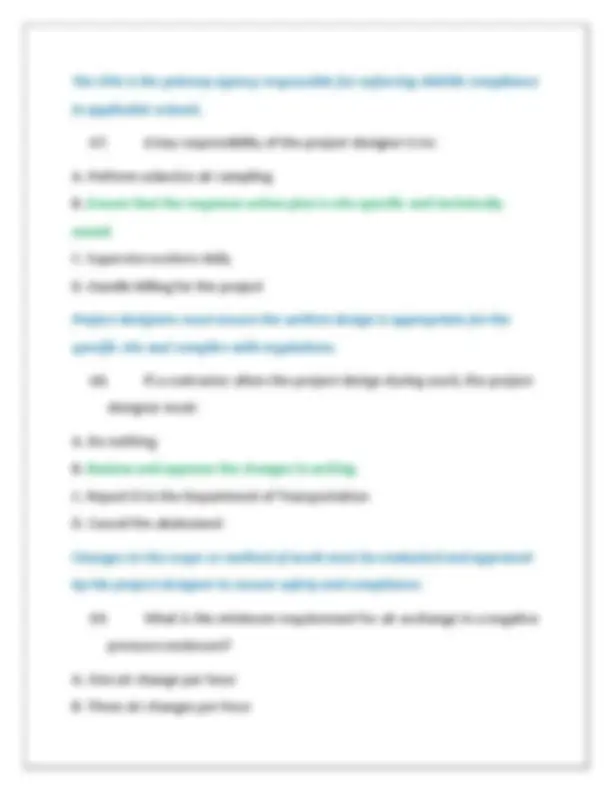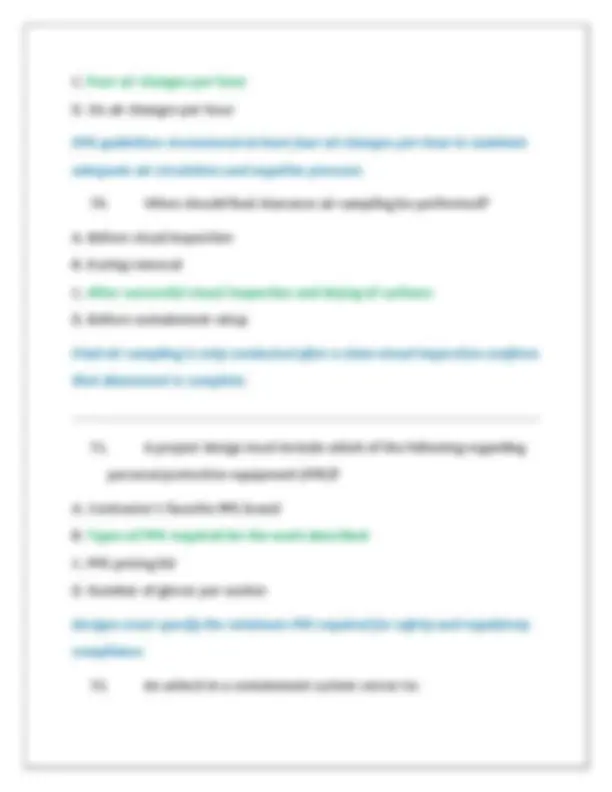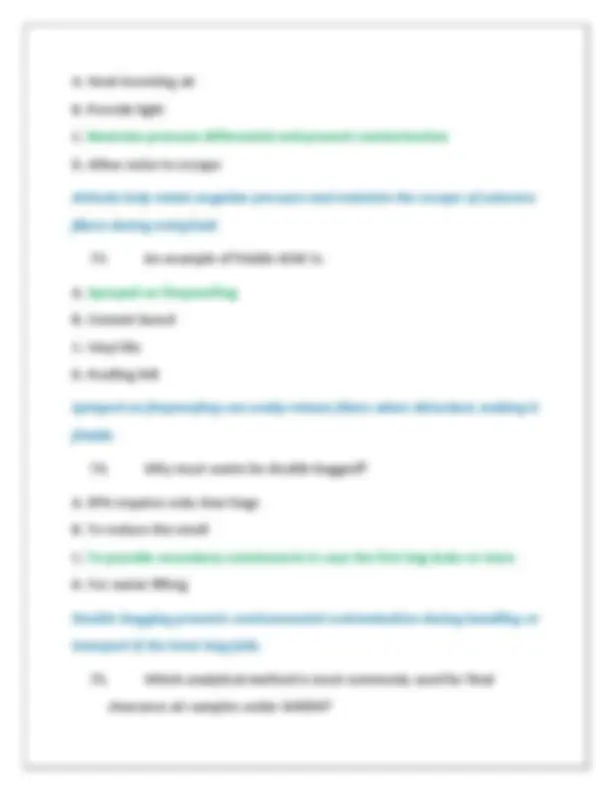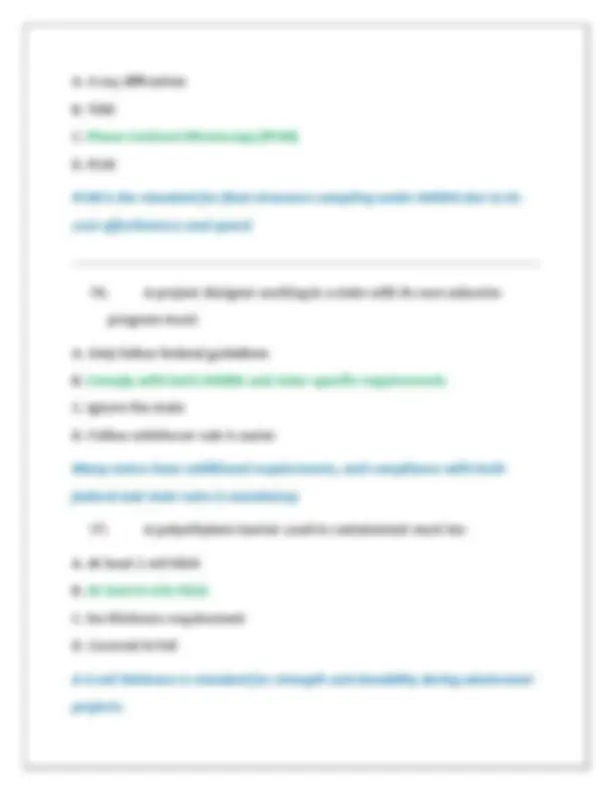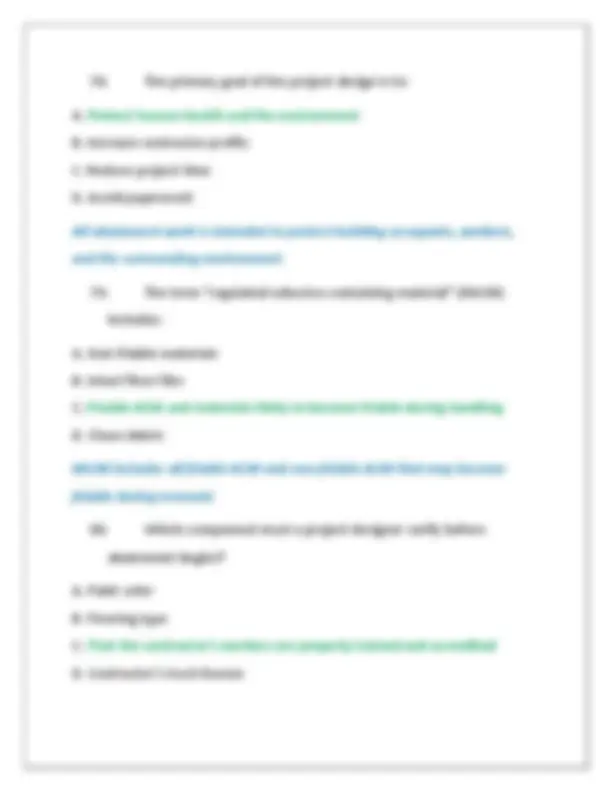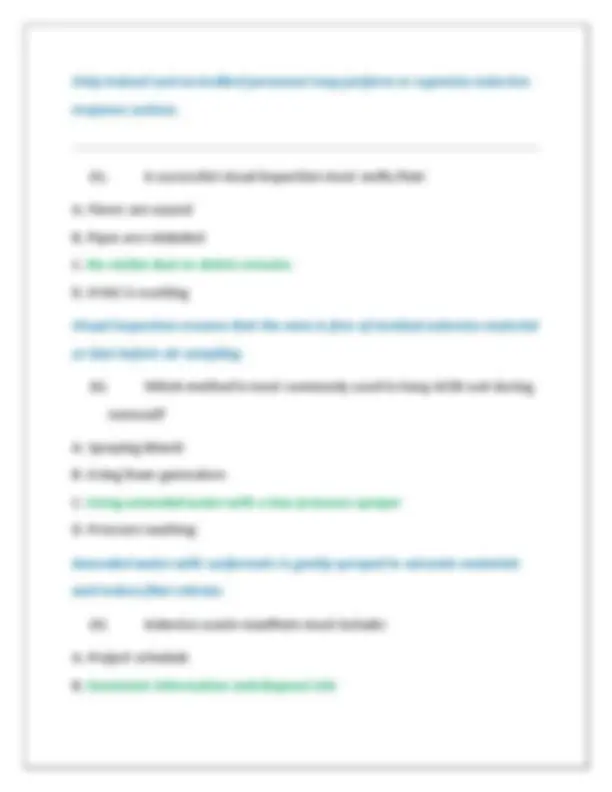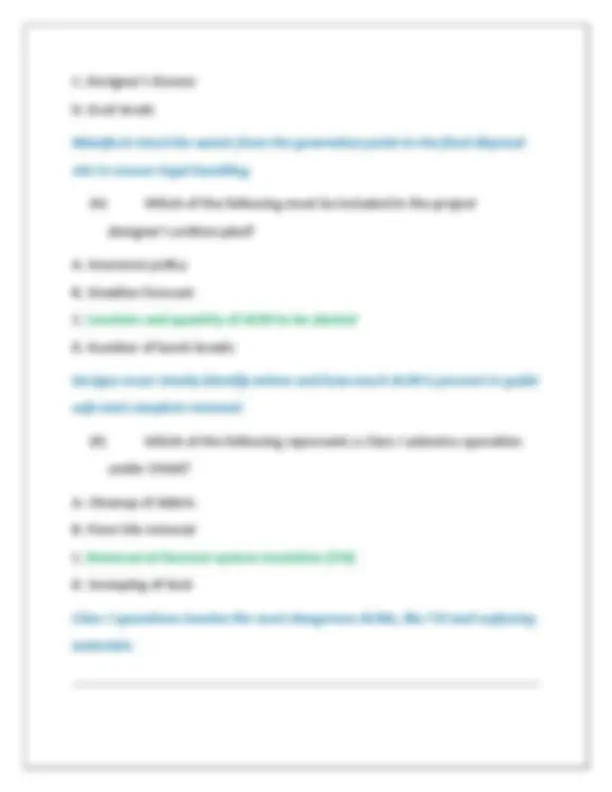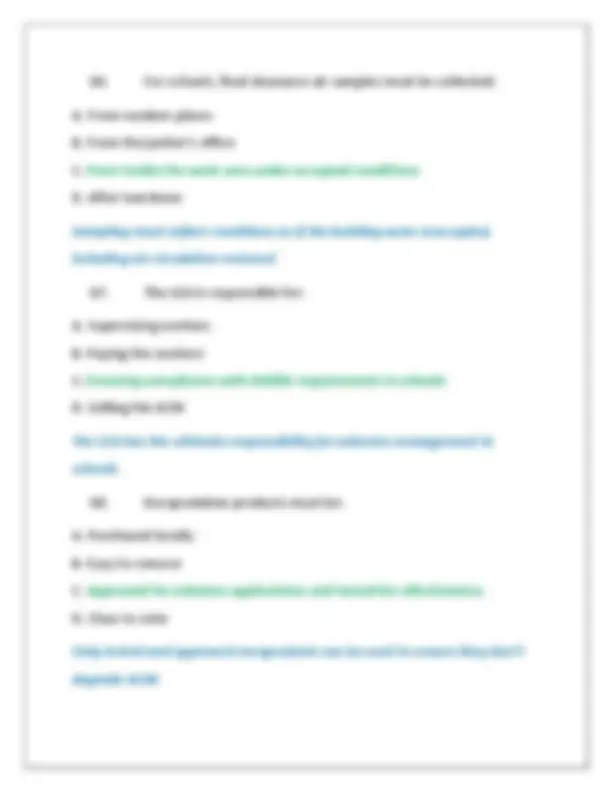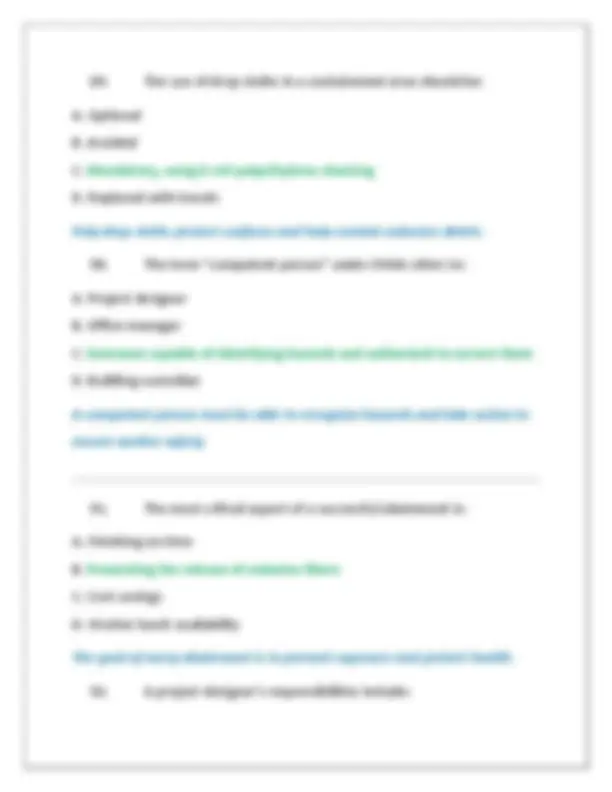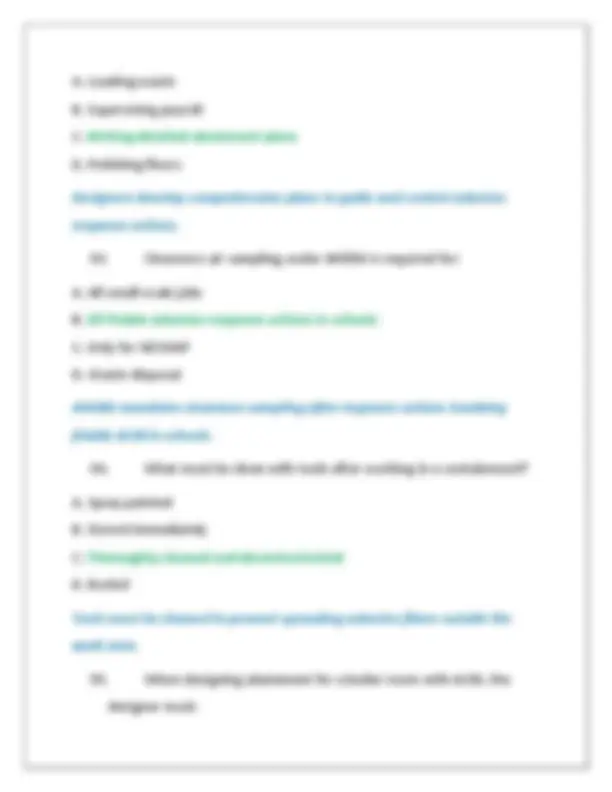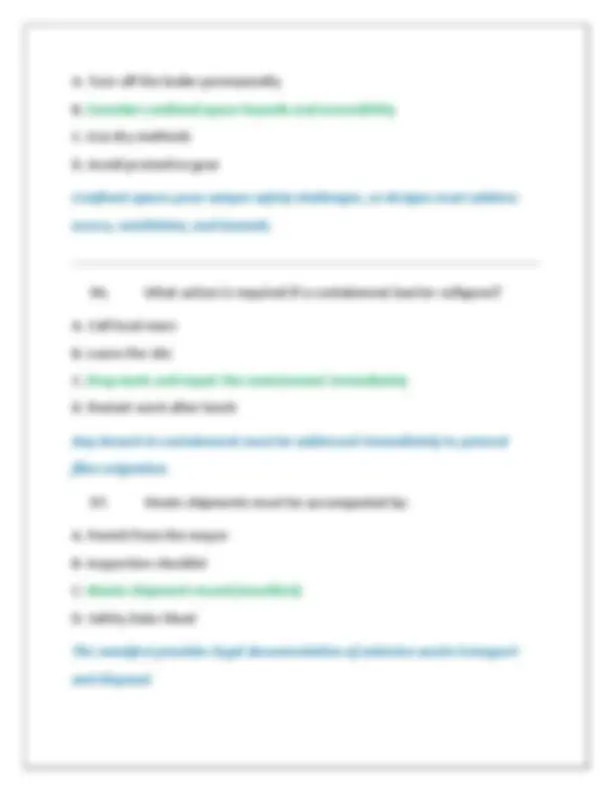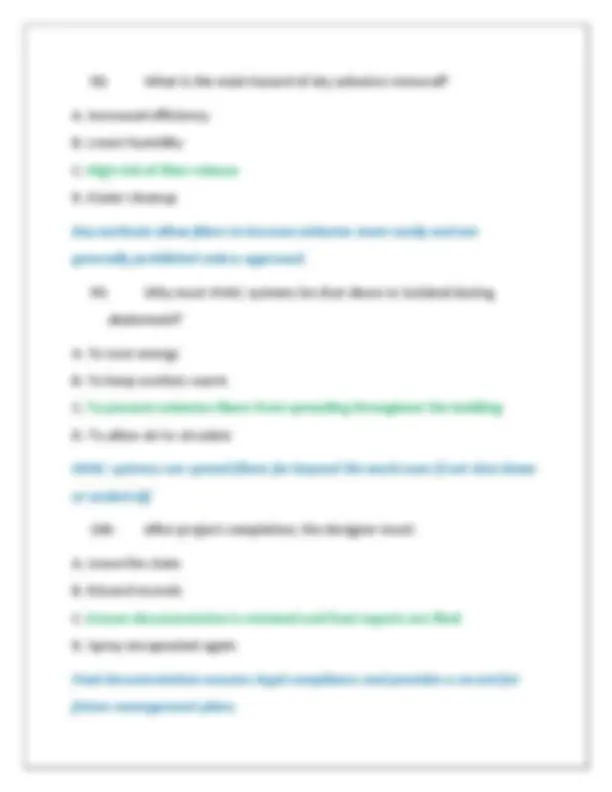Download AHERA Project Designer Certification Practice Exam 1 QUESTIONS AND CORRECT ANSWERS (VERI and more Quizzes Environmental Engineering in PDF only on Docsity!
AHERA Project Designer Certification
Practice Exam 1 QUESTIONS AND
CORRECT ANSWERS (VERIFIED
ANSWERS) PLUS RATIONALES 2025 Q&A
| INSTANT DOWNLOAD PDF
- Which regulation outlines the training requirements for asbestos project designers? A. OSHA 29 CFR 1910. B. EPA 40 CFR Part 763, Subpart E C. NESHAP 40 CFR Part 61 D. RCRA 40 CFR Part 261 EPA 40 CFR Part 763, Subpart E outlines the training and accreditation requirements for asbestos professionals, including project designers.
- A written project design must be developed for:
A. All renovations in schools B. Projects involving more than 3 linear feet of ACM C. Response actions in schools involving friable ACBM D. Any activity that disturbs asbestos AHERA requires a written design for response actions involving friable ACBM in schools.
- Under AHERA, who is responsible for reviewing and approving the project design? A. The EPA Regional Administrator B. The accredited Project Designer C. The asbestos abatement contractor D. The building maintenance supervisor Only an accredited Project Designer is authorized to prepare and approve the written project design.
- What is the primary reason for establishing a regulated work area? A. Increase labor efficiency B. Reduce disposal costs C. Prevent the spread of asbestos fibers D. Minimize the use of PPE Regulated areas are established to prevent airborne asbestos from migrating beyond the abatement zone.
The designer ensures that the project was completed in accordance with the design, including clearance protocols.
- Which document provides guidance for air sampling during asbestos abatement? A. OSHA 29 CFR 1926. B. NIOSH 7400 Method C. DOT 49 CFR D. RCRA Method 1311 The NIOSH 7400 method is commonly used to assess airborne asbestos fibers in abatement projects.
- Which of the following is required during the design of a large-scale asbestos abatement project? A. Weekly weather report B. Site-specific safety plan C. Monthly payroll summary D. Employee vacation schedule A site-specific safety plan ensures that hazards are addressed for that particular location.
- A glove bag is most appropriate for: A. Removing sprayed-on ACM B. Flooring tile removal
C. Pipe insulation on straight runs D. Transite panel demolition Glove bags are designed for small-scale, contained removal of pipe insulation.
- What is the primary goal of engineering controls in asbestos abatement? A. Lower insurance costs B. Reduce visual dust C. Minimize airborne fiber release D. Speed up removal Engineering controls such as HEPA ventilation and wet methods help prevent fiber release.
- The HEPA filter in a negative air machine must be capable of capturing particles of what minimum size? A. 5 microns B. 2 microns C. 0.5 microns D. 0.3 microns HEPA filters are rated to remove 99.97% of particles 0.3 microns or larger.
Encapsulation involves applying a sealant to ACM to prevent fibers from becoming airborne.
- A successful final visual inspection must confirm: A. All visible debris and residue is removed B. That a HEPA filter is present C. Negative air pressure was achieved D. Contractor hours are recorded Visual inspection ensures that all asbestos material has been removed and the area is visibly clean before clearance sampling.
- A major design consideration when working in a school environment is: A. Meal delivery B. Minimizing disruption to building occupants C. Painting schedules D. Access to parking AHERA prioritizes student and staff safety, so minimizing exposure and disruptions is key.
- A decontamination unit must have at least: A. One room B. Three chambers: clean room, shower, equipment room
C. Five chambers D. No specific requirement The three-stage decontamination unit ensures personnel do not carry asbestos fibers out of the work area.
- The term "friable" asbestos means: A. Material that’s in a sealed container B. Material that can be crumbled by hand pressure C. Non-airborne asbestos D. Material used in flooring Friable asbestos is dangerous because it can easily release fibers into the air.
- Which type of work area control is considered an administrative control? A. Negative air machines B. Enclosures C. Limiting access with signage and security D. HEPA vacuums Administrative controls include policies and procedures such as restricted access and posting warning signs.
- Which material is most likely to be classified as non-friable asbestos-containing material (ACM)?
- When should a project designer consider revising a project design? A. If project finishes ahead of schedule B. If site conditions change significantly C. After final clearance D. When the weather improves Any significant change in site conditions, such as discovery of unexpected ACM, requires a revision.
- For ACM debris, which waste label is required under EPA NESHAP? A. Class 3 Flammable B. Asbestos Hazardous Waste Label with DOT specifications C. Biohazard D. Combustible Solids EPA requires properly labeled asbestos waste bags per DOT and OSHA standards for transportation and disposal.
- A pre-cleaning of surfaces in the work area is required to: A. Reduce visual dust B. Eliminate loose dust before abatement begins C. Polish the flooring D. Ensure insulation adhesion
Pre-cleaning prevents settled dust from becoming airborne during removal.
- How often must a negative pressure system be monitored during abatement? A. Once a day B. Continuously during the entire abatement process C. Only before final inspection D. Weekly Continuous monitoring ensures that negative pressure is maintained and any loss is detected immediately.
- The function of polyethylene sheeting in abatement projects is: A. Prevent mold growth B. Provide a physical barrier to prevent contamination C. Insulate pipes D. Mark off exits Poly sheeting is a key material used to isolate work areas and prevent the spread of fibers.
- The final clearance air sampling in schools must meet which criteria? A. Two samples must be taken B. Airborne asbestos below 0.3 f/cc
- What should be done with friable asbestos-containing debris during removal? A. Dried and stored B. Burned on-site C. Placed in leak-tight containers or double-bagged D. Sent to a recycling center Debris must be contained to prevent fiber release and ensure legal disposal.
- The design for an asbestos enclosure must ensure that: A. ACM is painted B. The enclosure is airtight and mechanically secured C. Fibers are stirred before sealing D. ACM is exposed for ventilation Enclosures must be airtight and properly sealed to prevent fiber release.
- When is the project designer typically involved in the abatement process? A. Only during clearance B. After abatement C. Before, during (as needed), and post-abatement D. Only when a complaint is filed The designer may oversee compliance with the design throughout the process, not just in planning.
- Encapsulation is most appropriate when: A. ACM is completely degraded B. The material is in good condition but needs protection C. ACM is in floor tiles D. Sprayed-on insulation is deteriorated Encapsulation preserves ACM in good condition and prevents fiber release.
- If friable asbestos is discovered during renovation work without a project design, what is the appropriate course of action? A. Continue work B. Cover it with duct tape C. Stop work and prepare a written project design D. Inform neighbors AHERA mandates immediate response planning by a qualified designer when friable ACM is discovered.
- What is the purpose of smoke testing a containment? A. Check temperature B. Identify leaks in the containment system C. Remove odors D. Ensure vacuum is operational Smoke testing helps detect breaches in the containment barrier by visualizing air movement.
- The function of a HEPA vacuum in asbestos work is to: A. Provide warm air B. Capture and retain asbestos fibers C. Mix materials D. Test air quality HEPA vacuums remove asbestos particles without redistributing them into the air.
- Which tool must never be used during ACM removal? A. Scraper B. Power grinder without HEPA attachment C. Manual brush D. Spray bottle Power tools without HEPA filters generate high levels of airborne fibers and are prohibited.
- The glovebag technique is NOT suitable for: A. Pipe elbow joints B. Large-scale friable removals C. Vertical pipe runs D. Straight pipe sections
Glovebags are used for small-scale, localized removal and are not suitable for large-scale projects.
- If encapsulation is used as a response action, the project designer must: A. Remove all ACM afterward B. Skip clearance testing C. Ensure the encapsulant is compatible with the material and will not cause degradation D. Select randomly Using the wrong encapsulant can worsen conditions or cause material to degrade over time.
- Which activity does NOT require a written asbestos project design? A. Glovebag removal of <3 linear feet of pipe insulation B. Full removal of ceiling texture C. Enclosure of boiler lagging D. Removal of friable duct insulation Small-scale glovebag operations are exempt from formal project design under AHERA.
- The final step in a successful asbestos project design is:
- How long must project records be kept under AHERA? A. 1 year B. 3 years C. At least 30 years D. No requirement AHERA and OSHA require retention of asbestos-related records, such as air sampling data, for 30 years.
- Which of the following is the most protective respirator for asbestos abatement? A. Dust mask B. Half-face APR C. Powered air-purifying respirator (PAPR) with HEPA filters D. Paper surgical mask PAPRs offer the highest level of protection in many abatement settings due to positive pressure and filtration.
- A project designer must be accredited: A. Every 10 years B. Only once C. According to state and federal AHERA requirements, typically every year D. If requested by the contractor Accreditation must be maintained with periodic refresher training, often annually.
- Which agency regulates disposal of asbestos waste? A. Department of Education B. EPA under NESHAP and RCRA C. Department of Commerce D. FEMA EPA regulates asbestos disposal through NESHAP and the Resource Conservation and Recovery Act (RCRA).
- During design, ACM quantity is typically measured in: A. Gallons B. Pounds C. Square feet or linear feet D. Cubic inches The amount of ACM determines the response action and regulatory requirements.
- If ACM is discovered in a newly renovated school, the project designer must: A. Notify the media B. Create a design for removal or management in consultation with the LEA C. Close the school indefinitely D. Paint over it

